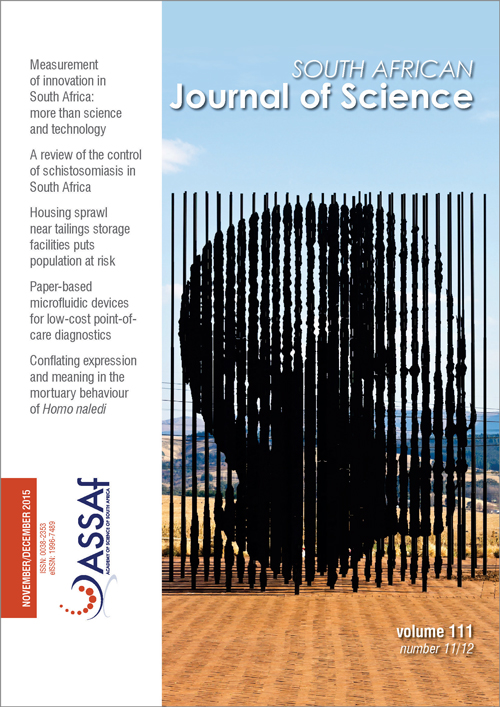A review of the control of schistosomiasis in South Africa
DOI:
https://doi.org/10.17159/sajs.2015/20140427Keywords:
neglected tropical disease, praziquantel, Schistosoma haematobium, female genital schistosomiasis, schoolchildrenAbstract
Schistosomiasis is the second most important tropical disease in the world in terms of public health impact. In South Africa, more than 4 million people are estimated to be infected with schistosomiasis. School-age children usually have the highest prevalence and intensity of infection. Schistosoma haematobium may result in female genital schistosomiasis which presents as inflammation and ulceration of the genital mucosa and pathological blood vessels. These effects may increase the susceptibility of women with female genital schistosomiasis to HIV. Praziquantel is the drug used to treat schistosomiasis and it is best to treat people during the early stages of infection, before female genital schistosomiasis presents as lesions and sandy patches, as there currently is no treatment for these symptoms. Schistosomiasis is not regarded as a serious public health issue in South Africa despite evidence revealing the seriousness of the disease. In areas endemic for schistosomiasis, the World Health Organization recommends regular mass treatment of all school-age children. In 2001, South Africa became a signatory to the World Health Assembly resolution 54.19 which urged all member states to achieve the minimum goal of 75% treatment coverage in school-age children at risk by 2010. This goal was not achieved in South Africa, despite efforts made by the Department of Health, such as the first statutory school-based geohelminth control programme in the province of KwaZulu-Natal. However, this programme has not been continued. Therefore, there is still much work to be done in order to control and decrease the prevalence of schistosomiasis in endemic areas.
Published
Issue
Section
License

All articles are published under a Creative Commons Attribution 4.0 International Licence
Copyright is retained by the authors. Readers are welcome to reproduce, share and adapt the content without permission provided the source is attributed.
Disclaimer: The publisher and editors accept no responsibility for statements made by the authors
How to Cite
- Abstract 2184
- PDF 1075
- EPUB 235
- XML 364












.png)